Lean management in companies
What is the lean method and why is it useful for companies
Lean management is business management conducted according to lean principles. When the lean method is applied in industrial manufacturing—the field in which the methodology first emerged—it is known as lean manufacturing.
The ultimate goal of the lean method is to boost production—offering more variants and higher quality, thereby achieving greater end‑customer satisfaction—while employing fewer resources, less inventory, and less labor, and thus incurring lower costs. In short, lean aims to raise a company’s profit margins and market competitiveness by reducing costs and increasing revenues.
That equation matters to every economic actor in any sector or market, which explains why, over the years, the lean methodology—both in manufacturing and as a broader mindset (lean thinking)—has gained such wide traction and success. Initially embraced mainly by large companies in the most capital‑intensive industries (no coincidence it was born in Toyota’s automotive sector), it is increasingly within reach of small and medium‑sized enterprises as well, because competitiveness and cost reduction are crucial for SMEs too.
The lean management strategy: key concepts of lean management (Lean Thinking, Toyota, and Kaizen)
Lean management is business management conducted according to lean principles. The application of the lean method in the manufacturing industry, where the methodology originally emerged, is called lean manufacturing.
The ultimate goal of the lean method is to increase production, with more variants and more quality, thus greater end customer satisfaction, with fewer resources, less inventory, and less labor, thus lower costs. In a nutshell, the methodology aims to increase the company’s profitability and competitiveness in the market, because it reduces costs and increases revenues.
This is an equation that affects all economic actors in any sector and market, which is why over the years the lean methodology, both at the manufacturing level and at the general level of thinking (lean thinking), has had such widespread acceptance and success. It was initially embraced mainly by large companies in the most capital intensive sectors (not coincidentally, it originated in Toyota’s automotive sector), but has been increasingly adopted by small and medium-sized enterprises, because the issue of competitiveness and cost reduction is also crucial for SMEs.
Historically, the lean method was developed, or rather was conceptualized, at Toyota between 1948 and 1975 and took the name Toyota Production System (TPS, or Toyotism). Since then, the application context has evolved, and the methodology has been applied in a wide variety of sectors, but the core lean thinking philosophy has not changed.
The basic idea of the TPS philosophy, in some respects an alternative to Henry Ford’s philosophy of large-scale mass production (“Any customer can get a colored car of any color he wants, as long as it is black”), is “doing more with less,” i.e. using the available resources in the most productive way possible with the aim of drastically increasing the productivity of the factory.
Kaizen is the composition of two Japanese terms KAI (change, improvement) and ZEN (good, better) together translate to continuous improvement and is one of the fundamental pillars of the Toyota Production System; one of the key concepts of the lean method, in fact, is that the organization must always strive for optimization by continually asking itself how to do better, looking for the cause of errors to prevent them from being repeated. This guarantees the company long-term sustainability in terms of performance and competitiveness.
Lean and digital: two indispensable steps for the innovation
The lean methodology is not in itself new and is not a particularly innovative topic, since it was born more than 50 years ago, but it is definitely current, and at this moment in time there is widespread interest from all companies in the most diverse sectors first, because the topic of costs and margins is of common interest, and, secondly, because the application of lean thinking is in some ways a prerequisite for a successful digital transformation.
In the LEF model company, it is possible to see firsthand and, literally, touch what lean manufacturing means and what it means to go from a lean factory to a 4.0 factory or vice versa. As we like to say on our visits to the model company, the ideal evolutionary path of a company is first to apply the lean methodology, lean manufacturing and lean management, and only then embrace Industry 4.0 automation and digitization.
This is because digitization serves to automate processes and operations, at different levels of the value chain, from the warehouse to the office, via the factory, of course; but if these upstream processes have not been analyzed and optimized in order to reduce waste or errors, translating them into digital means also digitizing waste and errors.
This is why any digital innovation project, first of all, must start from an optimized level of processes and systems; in most cases, companies, especially SMEs, have not reached this management maturity and this is why many digital innovation projects first require consultancy and/or training in business process engineering, in which lean thinking is undoubtedly one of the most widespread techniques.
